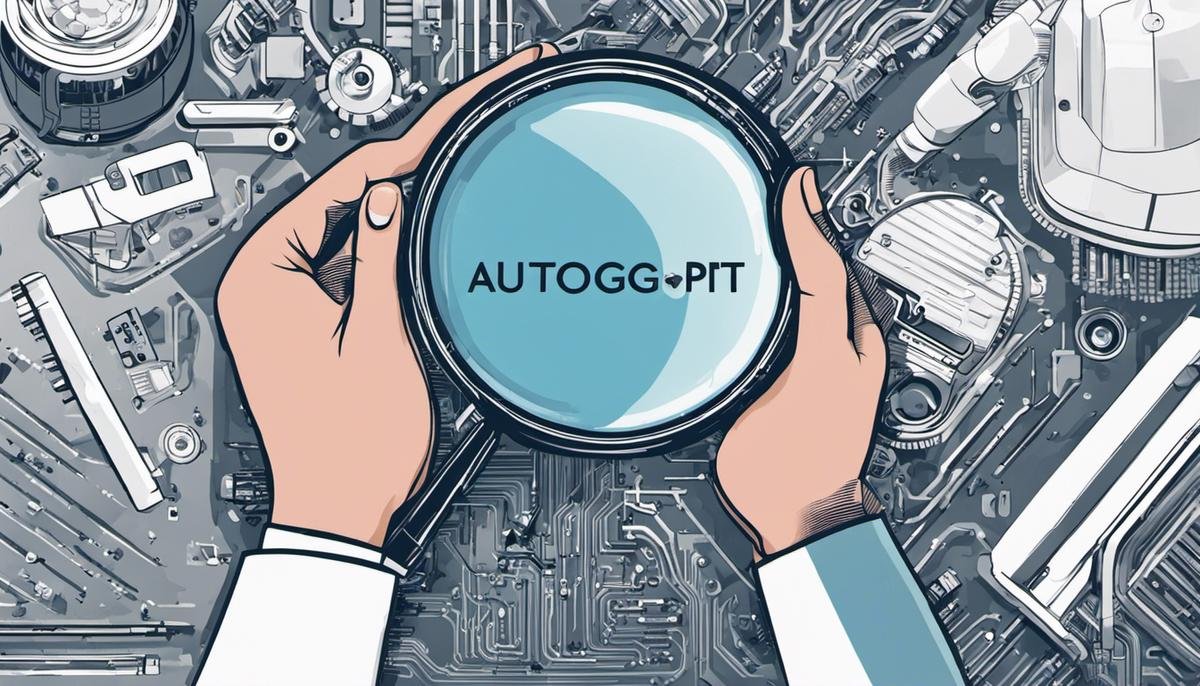Within the rapidly evolving landscape of machine learning, Autogpt is emerging as a formidable player in the game, with the potential to reshape the world of technology. As the intersection of artificial intelligence and automation, Autogpt is an essential tool for experts and novices alike, driving new innovations and advancements in machine learning. This discourse offers a comprehensive exploration of Autogpt and its transformative role in technology, from understanding its basic principles and significance in machine learning to practical guides on installation, setup, and problem-solving. Delving into real-life examples and discussions, we offer insights on the effective use of Autogpt for model training and prediction generation, troubleshooting, and visions of its future.
Understanding Autogpt in Machine Learning
Unveiling AutoGPT: The Evolutionary Leap in Machine Learning
Machine learning, the technology that affords computers the capacity to emulate human thought processes, continues to advance at an exhilarating pace. Among the freshest breakthroughs in this swiftly evolving field is AutoGPT, a pioneering approach that is uniquely contributing to the progress of machine learning. But how exactly does AutoGPT achieve this?
The secret sauce lies in a technology called Generative Pretraining Transformer (GPT). GPT is an algorithm designed to grasp language patterns using a method known as unsupervised learning. Simply put, it learns to predict the next word in a sentence, thereby gaining an understanding of context and word relations.
However, AutoGPT elevates this process a notch higher by exploiting the power of automation. This is where it crests a new wave in machine learning.
AutoGPT leverages automation to tune model parameters without human intervention, hence the prefix ‘Auto.’ This self-tuning capability is of paramount significance as it facilitates the creation of far more refined and effective machine learning models.
Conventionally, finetuning of machine learning models is largely manual and painstaking, requiring a significant investment of time and expertise. AutoGPT addresses this bottleneck by eliminating dependence on human manipulation, reshaping the boundaries of what machine learning models can accomplish.
With AutoGPT, the evolution of GPT models is also expedited. Traditionally, progressing a machine learning model from one version to another involves rigorous manual labor. However, with AutoGPT’s automated finetuning, machine learning models can swiftly evolve to deliver markedly superior performances.
Moreover, AutoGPT brings to the fore a scalability that is unprecedented. The approach allows for the integration of increasingly large and complex data sets, the lifeline of advanced machine learning. It permits the model to explore and learn from an expansive array of contexts, thereby enhancing its utility in diverse scenarios.
The implications of AutoGPT’s unique contribution to machine learning are profound, affecting everything from AI-driven chatbots to sophisticated natural language processing tools. Through automation, it not only amplifies the efficiency and adaptability of machine learning models but also greatly simplifies the task of the developers.
With the promise of systemizing and simplifying machine learning, AutoGPT is truly a potent catalyst propelling the progress of this cutting-edge technology to unchartered territories. It leverages the magic of automation to make machine learning not just faster and more efficient, but also more accessible. Undoubtedly, the advent of AutoGPT marks a significant milestone in the chronicles of machine learning evolution. Boldly breaking away from the established norms, it reinvents and redefines the game rules of machine learning.
As technology buffs, the thrill of such advancements in machine learning is unmatched. As we keenly watch the expansion of the AI frontier, AutoGPT offers an avant-garde glimpse into a future brimming with limitless possibilities.

Installation and Setting Up Autogpt
Following the incitements of AutoGPT and its influence on machine learning, it’s critical to understand the essential steps that contribute to its successful setup. A well-structured setup process not only enhances operational efficiency but also augments the benefits of this revolutionary tool, further contributing to the prospects of machine learning.
To begin with, install the necessary dependencies. AutoGPT calls for a robust computational setup that includes recent versions of Python packages like PyTorch and Numpy. Opting for an environment like Anaconda can simplify dependency management and process isolation.
Next, acquisition and preprocessing of the training data are vital. AutoGPT provides immense leeway in selecting data scales, ranging from small text data to vast machine learning datasets. However, preprocessed data is pivotal for AutoGPT to effectively tune the parameters, generate text, or understand the underlying patterns. Tools like NLTK, SpaCy, and Keras Tokenizer are quite resourceful in this phase.
Thirdly, go for the initialization and training of the AutoGPT model. This involves defining layer numbers, batch sizes, sequences, and more. Training can be CPU-intensive, especially for larger sequence lengths. Hence, consider hardware acceleration using GPUs. Additionally, maintain a careful balance to avoid overfitting. Regularization, early stopping, or dropout methods make a viable option for this.
Once trained, validation, and optimization of the AutoGPT model should ensue. This involves using separate validation data to assess model performance. Hyperparameter optimization too plays a notable role in refining the model outputs further and boost overall efficiency. AutoGPT’s automated finetuning capability can simplify this process significantly.
Finally, integrate the AutoGPT model into the desired applications. Whether it’s natural language processing, chatbots, or data analytics, AutoGPT’s flexibility seamlessly accommodates all.
To conclude, setting up AutoGPT involves well-articulated steps, each contributing to the successful application of this groundbreaking tool in machine learning. Adequate dependency management, careful data preprocessing, intensive model training, meticulous validation, and final application integration, all combine to harness the full potential of AutoGPT.
The tech horizon eagerly awaits more breakthroughs like AutoGPT. The doors are wide open for everyone passionate about the infinite possibilities that machine learning and AI offer — time to step in.

Using Autogpt for Model Training and Prediction Generation
AutoGPT is a remarkable tool, but to truly harness its power, one has to comprehend the intricacies involved in training models and generating predictions. It’s not just about setting parameters and pressing ‘Go’, there’s considerable sophistication lurking beneath the surface.
Firstly, the machine must be set up for the task. This involves installing the necessary dependencies, which encompasses a variety of Python libraries and tools, including the likes of PyTorch, TensorFlow, or Hugging Face Transformers. Ensuring that these dependencies are properly managed is critical to support consistency, isolating processes to prevent conflicts among libraries, each with their own diverse ecosystem of dependencies.
For employing AutoGPT, one needs data – and lots of it. But it’s not just about acquiring the data, it’s also about effectively preprocessing it. Employing tools such as NLTK, SpaCy, and Keras Tokenizer enable the extraction of valuable features from raw data, paving the path for efficient learning. Utmost care must be applied in balancing the datasets and avoiding biases that could skew the model’s learning.
Once the data is ready, the grand show begins. Parameters are initialized, and the model starts its training regime. However, anyone versed in machine learning knows the perils of overfitting. To mitigate that, AutoGPT ensures proportionate allocation of computational resources, emphasizing the significance of training with GPUs for complex, high-dimensional datasets.
Validation is integral in this process. It’s pivotal that trained models are tested, iteratively optimized, and validated. AutoGPT allows for a flourishing playground for data scientists, enabling hyperparameter optimization facilitated by automated fine-tuning. It revolutionizes the iterative process by pruning the need for manual tuning, speeding up the cycle of learning and refining.
Once satisfied with a model’s performance, the AutoGPT model is ready for integration. It proves its merit not only in its flexibility for integration into various applications, but also in its scalability. Be it embedded in AI chatbots, improving natural language processing tools, or bolstering decision-making tools in fields as diverse as finance, healthcare, and e-commerce, AutoGPT is up for the task.
In closing, AutoGPT also warrants consideration beyond its immediate functionality. It indicates a promising future, hinting at possibilities for even further automation and improvements in speed and efficiency. More efficient models, more refined AI tools, all beckoning an age of improved machine learning models and AI applications.
With AutoGPT, it’s clear that we are paving the way not just for the evolution of the machine learning landscape, but also for the widespread adoption of machine learning and AI in our daily lives – be it at work, at home, or anywhere in between. The future is here, and it’s indeed electrifying. Be ready to embrace it.

Overcoming Challenges and Troubleshooting Autogpt
While AutoGPT is undeniably revolutionary in its implications for AI and machine learning, it is not without challenges. Understanding these challenges allows for their effective mitigation and an overall better grasp on how to fully maximize AutoGPT’s potential. These challenges fall broadly into three categories: computational, oversight, and reliability.
On the computational front, the increased automation of model tuning with AutoGPT requires significant processing power. While this might not be a problem for larger organizations with hefty computational resources, it can limit the adoption of AutoGPT among smaller companies and independent developers. However, this hurdle can be navigated by utilizing cloud-based platforms like Google Colab or Amazon AWS that provide access to high-performance computing without implementing it in-house.
When it comes to oversight, AutoGPT’s automation of parameter tuning can become a double-edged sword. Although minimizing human intervention accelerates model tuning and fosters adaptability, there remains the risk of losing interpretability and control over the tuning process. As such, while the model may be achieving good results, the reasons behind these results may not be clearly understandable. Striking a balance here is key, perhaps by employing techniques that allow model transparency while still permitting automated tuning to occur.
Then, there’s the issue of reliability. AutoGPT’s heavy reliance on automation does raise the risk of model failure due to a lack of human monitoring. Automated systems might also overlook anomalies in the data that a human analyst would easily spot. Addressing this challenge requires the implementation of robust error tracking and exception handling mechanisms within the AutoGPT implementation. Having these mechanisms in place allows for rapid identification of problems and expedited troubleshooting.
Looking further, there’s also the question about the overall user-friendliness of AutoGPT. The advanced nature of GPT models and the reliance on automated fine-tuning could pose a challenge to developers with less experience in handling such technologies. The development of more user-friendly interfaces and the inclusion of more documentation could alleviate this challenge.
Lastly, due to the novelty of AutoGPT, there could be unforeseen challenges in integrating the automated model into various applications. Ensuring that the tool is adaptable and flexible enough, and can gracefully handle a variety of data types and structures, will be pivotal in overcoming this barrier.
Suffice to say, while AutoGPT paints a promising future for AI and machine learning, navigating its associated challenges is critical to its successful deployment. The trick lies in effectively leveraging available resources, securing solid oversight mechanisms, ensuring model reliability, improving user-friendliness, and planning for smooth integration. No doubt, the future of machine learning and AI is poised for phenomenal leaps, and AutoGPT will certainly play a significant role in this forward march.

Future of Autogpt in advancing Machine Learning
While AutoGPT is reshaping the machine learning landscape with its automated finetuning and ability to manage complex datasets, it remains essential to acknowledge the existing and potential hurdles that might affect the broader adoption and utility of this technology.
One of the foremost challenges lies in the realm of computational power. Machine learning, let alone AutoGPT, requires substantial processing capacity, which might be beyond the reach for many individuals or organizations. However, one effective solution resides in the use of cloud-based platforms like Microsoft Azure, Google Cloud, or Amazon Web Services. These platforms provide scalable computational resources on demand, thereby addressing the issue of processing power.
Yet, the path of AI and machine learning isn’t devoid of obstacles. As we automate more of the process, there are rising challenges around interpretability and oversight. With the automated tuning process in AutoGPT, there’s a risk of creating a black box, where model changes are made without a clear understanding of what’s happening. This raises potential ethical and procedural concerns that must be addressed by combining automation with checks and balances, thereby maintaining a balance between efficiency and transparency.
Another hurdle worth considering is reliability. Automation can bring about its own set of errors and exceptions. Robust error tracking and exception handling become paramount to ensure the reliable and consistent performance of the AutoGPT models.
Alongside these technical aspects, usability remains a significant factor in promoting the broader adoption of AutoGPT. Machine learning should not remain an esoteric field accessible only to experts. Progress in UI design, comprehensive documentation, and accessible interfaces becomes an integral part of AutoGPT’s journey. The need of the hour is making technology like AutoGPT user-friendly while keeping the integrity of the complex processes intact.
Integration also poses an interesting challenge. Different applications necessitate varied requirements. AutoGPT’s ability to adjust accordingly and handle different types of data structures widely impacts its versatile usage.
Lastly, amidst all these challenges, it’s crucial to keep in mind the bright future of this technology. The road might be rough, but the end promises a revolution in machine learning and AI. By effectively navigating the potential obstacles, developers can foster a more inclusive, advanced, and automated world, with AutoGPT at its core.

As we navigate the complex terrain of machine learning, the power and influence of Autogpt become increasingly undeniable. This extensive exploration of its functionalities and potential trajectories have demonstrated it as more than a mere automated tool – it represents a remarkable stride in technological advancement. With its growing capabilities, Autogpt may become a key driver in resolving numerous challenges in the tech industry, pushing the boundaries of machine learning. Progressing into the future, further developments and utilization of Autogpt present a picture of a world where machine learning is more accessible, reliable and transformative than ever before.




